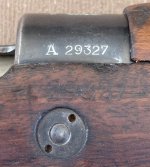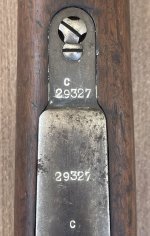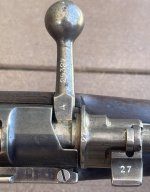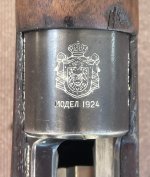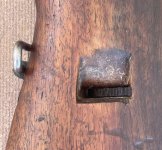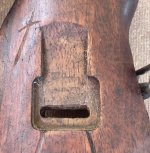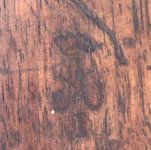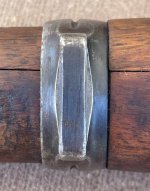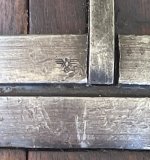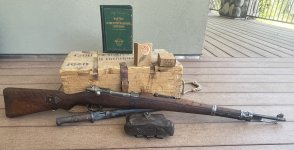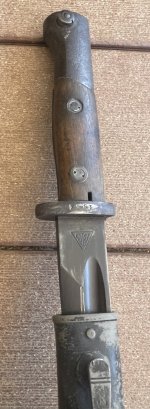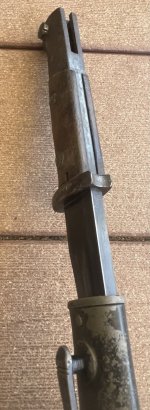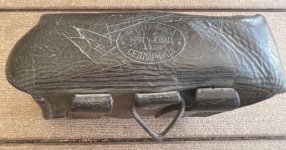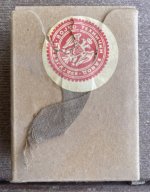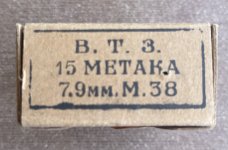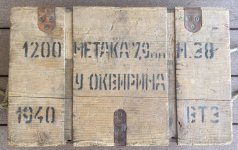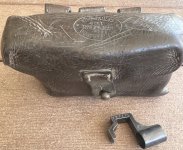I've been on the hunt for an all-matching, FN produced Yugoslav Mauser for a LONG time. Due to very small production numbers, battlefield attrition and the post-war Yugoslavia refurbishment of M1924 rifles into sterilized and scrubbed M.24/47 rifles, there have been very few that have survived intact and matching. These were made on an FN contract for the fledgling Kingdom of Serbs, Croats and Slovenes from 1926-1928. This was abbreviated on the receiver with 'CXC,' the Serbian Cyrillic letters denoting the three ethnic groups mentioned. FN stamped their own well known markings on the left side of the receiver rail, where one would later find the Cyrillic designation for the Kingdom of Yugoslavia.
This was later captured, probably in April 1941 during the German invasion of Yugoslavia, or the subsequent occupation. It was cycled through to the Ordnungspolizei, who apparently performed the following modifications:
- Stamping the safety, bolt gas shield and bottom of the rear sight ladder with the last two numbers of the serial number;
- Modifying the butt stock by creating a sling slot cut-out, as seen on K98k rifles;
- Modifying an unnumbered K98k rear barrel band by making an insert to accommodate the rifle's rear barrel band spring, and marking it with an Orpo stamp.
The above mentioned modification to the barrel band is only found on captured Yugoslav Mausers, as they used a narrower barrel band. By using a K98k style rear barrel band, this allowed them to utilize the option of side sling carry, as long the butt stock was cut for the sling. All of the numbers and stock stamps are visible and intact, with the stock cypher of King Alexander I (right side of the butt stock) being somewhat worn. The bore is in surprisingly excellent condition, although I've never seen even a pre-war Yugoslav Mauser with a bad bore. Maybe that's just luck. The Orpo modified M1924's are a known variant, but they're VERY tough to find, and tend to go high dollar when they surface. One sold in 2012 for around $2,600 at an auction that had other items go unexpectedly high, so they do enjoy some serious appeal.
Pat
This was later captured, probably in April 1941 during the German invasion of Yugoslavia, or the subsequent occupation. It was cycled through to the Ordnungspolizei, who apparently performed the following modifications:
- Stamping the safety, bolt gas shield and bottom of the rear sight ladder with the last two numbers of the serial number;
- Modifying the butt stock by creating a sling slot cut-out, as seen on K98k rifles;
- Modifying an unnumbered K98k rear barrel band by making an insert to accommodate the rifle's rear barrel band spring, and marking it with an Orpo stamp.
The above mentioned modification to the barrel band is only found on captured Yugoslav Mausers, as they used a narrower barrel band. By using a K98k style rear barrel band, this allowed them to utilize the option of side sling carry, as long the butt stock was cut for the sling. All of the numbers and stock stamps are visible and intact, with the stock cypher of King Alexander I (right side of the butt stock) being somewhat worn. The bore is in surprisingly excellent condition, although I've never seen even a pre-war Yugoslav Mauser with a bad bore. Maybe that's just luck. The Orpo modified M1924's are a known variant, but they're VERY tough to find, and tend to go high dollar when they surface. One sold in 2012 for around $2,600 at an auction that had other items go unexpectedly high, so they do enjoy some serious appeal.
Pat
Last edited:




